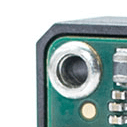Providing Heat Dissipation#
General Guidelines#
- Mount a lens on the camera.
- Mount the camera on a substantial, thermally conductive component. The contact surface should be even. On uneven surfaces, attaching a heat-conducting foil between camera and contact surface may be helpful.
- Attach appropriate cooling elements to the camera. Suitable cooling devices are available for most camera models and can be purchased via the Basler website.
- Provide an air flow over the camera.
- To ensure good image quality, Basler advises against operating the camera at elevated temperatures.
- If you want to check the camera temperature, you can measure it directly on the camera housing using the temperature measurement point (see below).
- Some cameras provide the Device Temperature feature. This feature lets you monitor the temperature of the device via the pylon API.
- Bear in mind that higher frame rates increase the power consumption, leading to a higher camera temperature.
- If the Camera Operation Mode feature is available on your camera and if operation at a lower frame rate is acceptable, set the operation mode to Long Exposure to reduce the temperature.
ace, ace 2, and racer 2 S Cameras#
Info
For cameras with Sony IMX and onsemi PYTHON sensors, the following application note is available: How to monitor the housing temperature of Basler ace cameras
Temperature Measurement Point#
boost Cameras#
boost V Temperature Measurement Point#
boost R Temperature Measurement Point#
racer 2 L Cameras#
On racer 2 L cameras, the temperature is best measured on the camera front. There is no specific measurement point.
dart Cameras#
Info
- If you use a heat conducting mat, you can further improve the heat dissipation.
- Make sure that the electrically conductive component for dissipating the heat, doesn't touch the electrical contacts on the board.
dart Classic/R/E#
On all dart Classic/R/E camera modules, there are four holes at the corners of the board, designed for installing the module. You can also use the holes to dissipate heat:
- Bare board variants: The metallic borders of the holes are designed to dissipate heat to connecting metallic components.
-
S-mount and CS-mount variants: Rivets are placed in the four holes. These rivets can be used to dissipate heat towards connected metallic components. For example, you can connect the camera front or rear to a mounting plate.

How to use the borders or rivets depends on your system design. In all cases, make sure that the borders or rivets have good contact with metallic components.
dart USB 3.0 Temperature Measurement Point#
Bare Board Models#
S-Mount and CS-Mount Models#
dart E Temperature Measurement Point#
Bare Board Models#
S-Mount Models#
dart M#
On all dart M camera modules, there are four holes lined with a copper layer and located at the corners of the board. These holes are designed for installing the module (and the mount).
The dart M Screw Kit for Mount Attachment can be used for mounting the camera module.
CAUTION – Temperatures outside of the specified range may cause burns or lead to a camera shutdown.
Operating the camera module at temperatures outside of the range given in the camera specification causes the following problems:
- The camera module gets hot and may cause burns when touching it.
- Operating the camera module without heat dissipation may lead to a shutdown of the camera module in order to protect its electrical components.
- The camera module's lifetime decreases.
Ensure sufficient heat dissipation. For more information, see the following section.
For dissipating heat, you have different possibilities, for example:
- You can use the screws for mounting the dart M camera module onto a heat sink.
As the dart M mounts are of a high-performance plastic with good thermal conductivity, the mounts can be used for heat dissipation. - You have the option to connect a heat sink directly onto the surface of the FPGA. To enhance heat dissipation even further, consider connecting the heat sink to a metal case or housing.
-
Heat Sink for dart (for evaluation purposes only):
The heat sink can be attached to the FPGA of the camera module via the pre-installed glue pad.
For further background information, see the How to Effectively Provide Heat Dissipation for dart M Camera Modules application note.